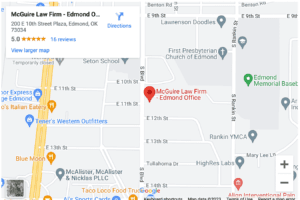Most Dangerous Highways in Oklahoma City

According to auto insurance studies, Oklahoma City drivers rank 35th in safety among the country’s largest 75 cities.
Oklahoma City’s accident rate of 143 car accidents per 5,000 residents makes it the most crash-prone city in Oklahoma. This accident rate exceeds the national average.
But these numbers do not tell the full story. Oklahoma City has a dangerous mix of traffic and open spaces. Some highways allow drivers to travel up to 80 miles per hour, although most highways in the city have speed limits of 65 or 70 miles per hour. High speeds and heavy traffic increase the risk of car accidents.
Here are some of the things you should know about car accidents and the most dangerous highways in Oklahoma.
How Oklahoma Car Accidents Happen
According to the U.S. National Highway Traffic Safety Administration (NHTSA), driver error causes more accidents than any other factor. Driver errors represent the critical factor in 94% of automobile crashes in the U.S.. Other critical factors include vehicle malfunction (2%), road and weather conditions (2%), and unknown causes (2%).
Driver Errors
The NHTSA breaks down driver error into three types:
Recognition Errors
Recognition errors cause more accidents than any other type of driver error.
Recognition errors include:
- Inattentive driving
- Distracted driving, including distractions from cell phones, radios, and GPS navigation systems
- Improper surveillance, including crashes that occurred because a driver “did not see” the other car
Recognition errors caused about 41% of the car accidents studied.
Decision Errors
Decision errors include judgment errors about your vehicle, the road, or other vehicles on the road.
Some examples of decision errors include:
- Speeding
- Driving too fast for the weather conditions
- Driving too fast for the road conditions or curves
- Making bad assumptions about other drivers’ actions
- Misjudging the speed of another vehicle
- Misjudging the distance to another vehicle or the gap between vehicles
- Making illegal maneuvers
Decision errors caused about 33% of car accidents in the study.
Performance Errors
Performance errors occur when the driver’s skills do not adequately meet the needs of the situation, including:
- Overcompensating or overcorrecting the vehicle’s direction or speed
- Steering errors
- Drowsy driving
- Impaired driving
Performance errors led to about 11% of car accidents during the study period.
What Makes a Dangerous Highway?
Some highways experience a higher accident rate for a few reasons:
Poor Road Design
Short merge lanes, tight curves, and high speed limits can increase the risk or severity of accidents on the highway. Traffic that exceeds the road’s capacity can amplify the negative effects of poor road design.
Poor Road Conditions
Weather, construction, and poor road maintenance can increase the danger of driving on some highways. Poor road design may combine with poor road conditions to turn hazardous roads into virtual death traps in bad weather.
View Obstructions
Blind intersections, hills, and even glare can inhibit a driver from seeing the road and traffic well enough to drive safely.
Signs
Signs can contribute to traffic accidents when they are poorly located, poorly lit, or obscured by trees or other signs.
Signals
The location of signals -- or lack of signals -- can contribute to traffic accidents. For example, vehicles that cross highways without a traffic control signal can pose a risk to vehicles traveling in all four directions.
List of Dangerous Highways in Oklahoma City
Oklahoma defines “highways” to include turnpikes, interstates, and state highways. Oklahoma maintains over 116,000 miles of rural, urban, and urbanized highways. Oklahoma classifies most of its highways as rural.
Oklahoma City and Tulsa contain most of Oklahoma’s 18,000 miles of urban and urbanized highways. Here are some of the most dangerous sections of those highways.
Interchange of I-40 and I-235
This interchange brings together two of Oklahoma City’s most heavily traveled highways. I-40 is the major east-west artery through Oklahoma City, and I-235 provides access from I-40 and I-35 to the downtown area. Vehicles will often slow down or stop in heavy traffic near the interchange.
Visitors to Oklahoma City use I-235 to access many downtown attractions, including the Oklahoma State Capitol, the Oklahoma City National Memorial, and the Oklahoma History Center. Combined with the daily commuters, these visitors can jam the highways near the interchange during the daytime.
Interchange of I-240 and I-35
This interchange carries commuters from communities south, east, and west of Oklahoma City into the city for work. Communities like Norman and Moore rely on I-35 to reach the city.
I-240 serves the airport for passengers traveling from the south or the east. I-240 also provides a route around downtown Oklahoma City. Rather than getting bogged down in traffic on I-40, semi-trucks passing through the area will often take I-240 and avoid the city altogether. The heavy truck traffic combines with commuter traffic to increase the risk of truck accidents at this interchange.
Turner Turnpike
This highway provides the fastest and most direct route for traveling between Oklahoma’s two largest cities. The heavily traveled highway connects Oklahoma City and Tulsa. It has a speed limit of 80 miles per hour. This speed limit allows a vehicle to travel between the two cities in under 90 minutes without speeding. This also makes the turnpike one of the most dangerous stretches of highway in Oklahoma.
State Highway 9
State Highway 9 (SR-9) has a dubious reputation. ValuePenguin, a financial analysis website, dubbed SR-9 just south of Oklahoma City as the second-most dangerous highway in America. The highway saw 50 fatalities over seven years from 2010 to 2016.
I-240
I-240 is heavily traveled by commuters and trucks that are trying to avoid heavy traffic on I-40. The stretch between I-44 and I-35 is particularly busy. Adding to the problem, the Oklahoma Department of Transportation is in the middle of a 10-year construction project to upgrade I-240. This project started in 2016 and will continue until 2026. Until the highway construction ends, this stretch of road will continue to be one of the most dangerous highways in Oklahoma City.
Accidents on Oklahoma’s Highways
Oklahoma uses an at-fault insurance system. This means that liability for car accidents in Oklahoma falls on the at-fault driver’s insurance provider. After an accident on one of Oklahoma’s highways, obtain the insurance information for all the other drivers involved so that you can pursue compensation for any injuries and property damage that you may suffer.
Common Auto Accident Claims in Oklahoma
At McGuire Law Firm you can trust our attorneys to handle your claim after your car crash. We handle:
- Red and yellow light crashes
- Uninsured motorist claims
- Self-driving car collisions
- Commercial vehicle crashes
- Left-turn crashes
- And more
Contact our Oklahoma City Car Wreck Lawyers Today
Have you been injured in a car accident in Oklahoma City due to someone else's wrongdoing? Contact McGuire Law Firm to help you secure a financial award. We have over 60 years of experience handling all types of car accidents and helping victims like you recover money for their damages. Give our attorneys a call today to schedule your free initial consultation.
Related Articles
- Can I Be Compensated For Pre-Existing Conditions After a Car Accident?
- Can I Be Reimbursed for Lost Wages After a Car Accident?
- Causes & Determining Fault for Car Accidents
- Oklahoma City Child Car Seat Laws
- Do I Need a Lawyer After a Hit and Run Accident?
- Oklahoma City Auto Accident Statistics
- What if the Other Driver Doesn’t Have Insurance?

